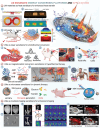Liquid Metal as Energy Conversion Sensitizers: Materials and Applications
- PMID: 38468447
- PMCID: PMC11462305
- DOI: 10.1002/advs.202304777
Liquid Metal as Energy Conversion Sensitizers: Materials and Applications
Abstract
Energy can exist in nature in a wide range of forms. Energy conversion refers to the process in which energy is converted from one form to another, and this process will be greatly enhanced by energy conversion sensitizers. Recently, an emerging class of new materials, namely liquid metals (LMs), shows excellent prospects as highly versatile materials. Notably, in terms of energy delivery and conversion, LMs functional materials are chemical responsive, heat-responsive, photo-responsive, magnetic-responsive, microwave-responsive, and medical imaging responsive. All these intrinsic virtues enabled promising applications in energy conversion, which means LMs can act as energy sensitizers for enhancing energy conversion and transport. Herein, first the unique properties of the light, heat, magnetic and microwave converting capacity of gallium-based LMs materials are summarized. Then platforms and applications of LM-based energy conversion sensitizers are highlighted. Finally, some of the potential applications and opportunities of LMs are prospected as energy conversion sensitizers in the future, as well as unresolved challenges. Collectively, it is believed that this review provides a clear perspective for LMs mediated energy conversion, and this topic will help deepen knowledge of the physical chemistry properties of LMs functional materials.
Keywords: energy conversion; liquid metal; sensitizers.
© 2023 The Authors. Advanced Science published by Wiley‐VCH GmbH.
Conflict of interest statement
The authors declare no conflict of interest.
Figures








Similar articles
-
Emerging Role of Liquid Metals in Sensing.ACS Sens. 2022 Feb 25;7(2):386-408. doi: 10.1021/acssensors.1c02606. Epub 2022 Feb 4. ACS Sens. 2022. PMID: 35119830 Review.
-
Recent advances and progress on the design, fabrication and biomedical applications of Gallium liquid metals-based functional materials.Colloids Surf B Biointerfaces. 2024 Jun;238:113888. doi: 10.1016/j.colsurfb.2024.113888. Epub 2024 Apr 1. Colloids Surf B Biointerfaces. 2024. PMID: 38599077 Review.
-
Unique Surface Fluorescence Induced from the Core-Shell Structure of Gallium-Based Liquid Metals Prepared by Thermal Oxidation Processing.ACS Appl Mater Interfaces. 2022 Aug 31;14(34):39654-39664. doi: 10.1021/acsami.2c12420. Epub 2022 Aug 18. ACS Appl Mater Interfaces. 2022. PMID: 35979950
-
Bismuth-based liquid metals: advances, applications, and prospects.Mater Horiz. 2024 Mar 18;11(6):1369-1394. doi: 10.1039/d3mh01722b. Mater Horiz. 2024. PMID: 38224183 Review.
-
Current progress in gallium-based liquid metals for combinatory phototherapeutic anticancer applications.Colloids Surf B Biointerfaces. 2023 Jun;226:113294. doi: 10.1016/j.colsurfb.2023.113294. Epub 2023 Apr 6. Colloids Surf B Biointerfaces. 2023. PMID: 37043951 Review.
References
-
- a) Aricò A. S., Bruce P., Scrosati B., Tarascon J.‐M., Van Schalkwijk W., Nat. Mater. 2005, 4, 366; - PubMed
- b) Holdren J. P., Popul. Environ. 1991, 12, 231;
- c) Tao H., Fan Q., Ma T., Liu S., Gysling H., Texter J., Guo F., Sun Z., Prog. Mater. Sci. 2020, 111, 100637.
-
- a) Falk G., Herrmann F., Schmid G. B., Am. J. Phys. 1983, 51, 1074;
- b) Molaeimanesh G. R., Nasiry S. M. M., Dahmardeh M., Appl. Therm. Eng. 2020, 181, 116028;
- c) Wang Y., Liang X., Zhu H., Xin J. H., Zhang Q., Zhu S., Adv. Funct. Mater. 2020, 30, 1907851.
-
- a) Xiao K., Chen L., Chen R., Heil T., Lemus S. D. C., Fan F., Wen L., Jiang L., Antonietti M., Nat. Commun. 2019, 10, 74; - PMC - PubMed
- b) Chen J., Glaus C., Laforest R., Zhang Q., Yang M., Gidding M., Welch M. J., Xia Y. J. S., 2010, 6, 811; - PMC - PubMed
- c) Albanese A., Chan W. C. W., ACS Nano 2011, 5, 5478; - PubMed
- d) Tong Y., Boldoo T., Ham J., Cho H., Energy 2020, 196, 117086.
-
- a) Xie W., Allioux F.‐M., Ou J. Z., Miyako E., Tang S.‐Y., Kalantar‐Zadeh K., Trends Biotechnol. 2021, 39, 624; - PubMed
- b) Gao J.‐Y., Chen S., Liu T.‐Y., Ye J., Liu J., Mater. Today 2021, 49, 201;
- c) Kwon K. Y., Truong V. K., Krisnadi F., Im S., Ma J., Mehrabian N., Kim T.‐I., Dickey M. D., Adv. Intell. Syst. 2020, 3, 2000159;
- d) Varnava C., Nat. Electron. 2019, 2, 52.
-
- Zuraiqi K., Zavabeti A., Allioux F.‐M., Tang J., Nguyen C. K., Tafazolymotie P., Mayyas M., Ramarao A. V., Spencer M., Shah K., Mcconville C. F., Kalantar‐Zadeh K., Chiang K., Daeneke T., Joule 2020, 4, 2290.
Publication types
Grants and funding
LinkOut - more resources
Full Text Sources
